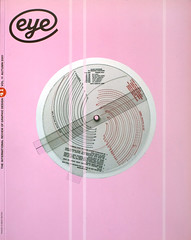Autumn 2001
Vanishing point
A slender idea is inflated to attention-grabbing proportions. Critique by Rick Poynor
For several years now there have been rumours that a monograph by The Designers Republic (TDR) was in the works. There is not much doubt that if the book ever arrives, designers will snap it up. TDR like to claim they are a ‘cult’ and there is some truth is this boast. People often cite the early 1990s issue of Emigre devoted to the Sheffield-based design unit as one of their favourites, and some kind of reassessment is long overdue.
3D>2D (Laurence King) is being promoted as if it were the retrospective, but it is something quite different – a slender idea graphically inflated to attention-grabbing proportions. Ostensibly, this is a book about a building, though probably not one you have previously heard about unless you read the architecture mags: the Chamber of Commerce and Industry designed by Sadar Vuga Arhitekti in Llubljana, capital of Slovenia. It is routine now for halfway significant buildings to command their own monographs, often as part of a series. Most of these books are variations on a formula: big, flattering, colour photographs taken by an ace photographer, explanatory plans and drawings, and a thorough, respectful, critical text. They are aimed at people with a genuine interest in architecture, often professionals who need to keep up with the latest developments.
TDR’s ‘adventures in and out of architecture’, as the book’s subtitle has it, purport to explore ‘a new approach to presenting and even experiencing an architectural product in book form’ – according to the designers – though my guess is many architects will hate it. As its metal ring binder immediately signals, 3D>2D hopes to be consumed as a graphic object by print production fetishists. The covers are made of heavy board, and many of the wide, landscape pages fold out, sometimes in several directions. The graphic mannerisms will be familiar to anyone who knows TDR’s work: a cold, technical type style (Isonorm); endless sheets of replicating, hardcore graphic texture – rules, arrows, graph paper, pictograms; an array of abstract, possibly arbitrary, geometrical shapes; and photos treated by assorted graphic filters to give the subject matter a detached, 21st-century, techno ambience.
These devices are layered on so thickly that the building itself – not to mention its urban context – seems to disappear. There is not a single, clear view of it in the book. The one large colour picture of the interior by Andreas Gursky merely confirms the overwhelming sensation of bureaucratic blankness. On a torn fragment of paper, the critic Ole Bouman asks himself whether the building is a thing – a thing in itself. ‘No,’ he concludes. ‘The thing is no longer in itself. It has lost itself.’ The architects say their creation corresponds in some way to the ‘deterritorialization of capital’. A provocative claim, but extracting further analysis will require twenty-twenty vision or an exceptionally high pain threshold, since TDR have wittily elected to set all the texts in long lines of microscopic, salmon-pink caps. (They do, however, supply typeface details in big, readable type.)
Directly translating the experience of built form into book form is clearly an impossible task. There can be no meaningful correlation between turning pages at a table and understanding a building as a body moving through levels of space. To do that you must go there, and at least one function of an architecture book is to show the building clearly enough to inspire you to want to bother. Does anyone involved in 3D>2D (apart from the architects) really believe the Chamber of Commerce and Industry merits all this fuss? It’s hard not to conclude that, in TDR’s case, it’s just a postmodern pretext for an extended graphic workout. Any other good-ish new building would have served. There are occasional flashes of their sharp visual and verbal humour, but mostly it, too, goes missing in the info-blizzard. Graphic designers are too much in awe of architects – just stop for a moment and listen to some of these guys. On the other hand, maybe TDR see through the baloney and some roguish deposit of irony permeates the whole thing. Professor Jeffrey Kipnis, easily the book’s most wilfully abstruse contributor – he actually doubts anyone is managing to follow his musings – suddenly puts on his party clothes to sum up Sadar Vuga’s building as, ‘A very good first single.’ What we have here, then, is a whole book lavishly devoted to a ‘first single’. Madonna herself never managed to pull that one off.
Rick Poynor, writer, founding editor of Eye, London
First published in Eye no. 41 vol. 11, 2001
Eye is the world’s most beautiful and collectable graphic design journal, published quarterly for professional designers, students and anyone interested in critical, informed writing about graphic design and visual culture. It is available from all good design bookshops and online at the Eye shop, where you can buy subscriptions and single issues.

